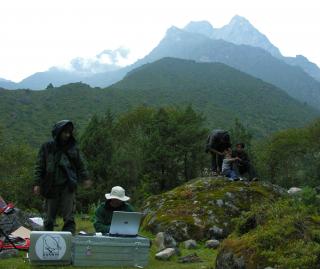Florisitics Raising Scotland's International Outreach In Global Biodiversity Conservation And Sustainable Use
Published on 18 March 2010 in Ecosystems and biodiversity

Introduction
Effective biodiversity conservation depends on the accurate knowledge of plants and their habitats found in Floras.
We need to be able to identify species, know their distributions and uses, understand their habitats and threats, and communicate the information using a reliable system of names. In Scotland these base-line data are well established, giving us an enviable foundation for our own planning for a sustainable future.
However, biodiversity conservation in many countries is severely hampered by the paucity of these fundamental data, limiting their development and having knock-on effects globally.
Floristic research addresses this urgent need, working in partnership to establish and communicate reliable base-line data and build in-country capacity for continued biodiversity research and conservation.
Key Points
Most people in developing countries rely heavily on plant resources for their livelihood, but these countries often lack basic biodiversity data and botanical expertise with which to plan for conservation and sustainable use.
Scotland’s rich heritage of collections and expertise on the plants of developing countries enables us to take a lead in working with governments and international environmental organisations.
Scotland’s obligations under the Convention on Biological Diversity include utilising our collections and knowledge, and using our expertise to increase capacity for indigenous plant biodiversity research through training and collaboration.
Scotland’s floristic research programmes have established international networks with biologists, conservationists, environmental organisations and governments, establishing Scotland as a major player in global biodiversity initiatives.
Research Undertaken
Scottish botanists figure prominently in the history of overseas exploration, with the legacy of their collections preserved in our herbaria, museums and libraries. Historical herbarium specimens are invaluable because of their role within the International Code of Botanical Nomenclature in assigning the correct names to species described during the explosion of biodiversity research in the 19th and 20th centuries. They are also the earliest plant occurrence records for these countries, and so an important base for later discoveries. RBGE focuses its research on countries where our collections are strong, building on these through collaborative fieldwork, engaging in training and capacity building activities and developing networks for research and knowledge exchange.
.jpg)
The Sino-Himalayan global biodiversity hotspot is one of RBGE’s major strategic research areas. Our collections from this region date back to 1802 when RBGE-trained Francis Buchanan Hamilton made the first botanical collections from Nepal. RBGE led in the production of the 25-year, 9-volume Flora of Bhutan, is a major partner for the nearly complete 25-volume Flora of China, and is now co-ordinating the Flora of Nepal. RBGE’s work in Nepal demonstrates the positive impact of capacity building activities in helping developing countries participate in biodiversity research. A 3-year training programme funded by the UK Darwin Initiative has led on to further academic training and increased research activity in Nepal.
RBGE’s other flagship floristic project is the Flora of the Arabian Peninsular and Socotra. This also demonstrates the long term nature of regional floristic research and the benefits to Scotland of extended outreach and influence. Our research in Arabia dates back to the 1960’s and involves collaborating with seven countries at all levels up to that of Government. RBGE scientists are now involved in decision making on issues of conservation and sustainable use throughout the Middle East, providing advice to Government and bringing plant knowledge into collaborations with environmental organisations. RBGE recently established the Centre for Middle Eastern Plants to promote research and development in plant conservation in the area and to take advantage of commercial opportunities in this sector.
Both the Arabian and Nepalese flora projects are taking new digital approaches to data gathering and provision of information. Electronic floristic outputs via the internet extend the availability of this information and makes it possible to provide specimen level data for re-use by others in their research. Time-stamped geo-referenced occurrence data generated from this research can be fed directly into geo-spatial analyses and used, for example, to predict vegetation changes under climate change scenarios or map resources for sustainable use planning.
Policy Implications
Understanding the components of plant biodiversity is a key first stage in developing effective strategies for conservation and sustainable use. Floristic research provides these fundamental data, but this needs a long term commitment and few institutes can lead on this work.
Scotland has a duty under the Convention on Biological Diversity to preserve and utilise historic materials collected from developing countries and to help them to conserve their plants. Through its involvement in and promotion of floristic research Scotland is extending its international outreach and influence, especially with governments and high profile international organisations.
Author
Dr Mark Watson, Major Floras Programme, Royal Botanic Garden Edinburgh m.watson@rbge.org.ul







